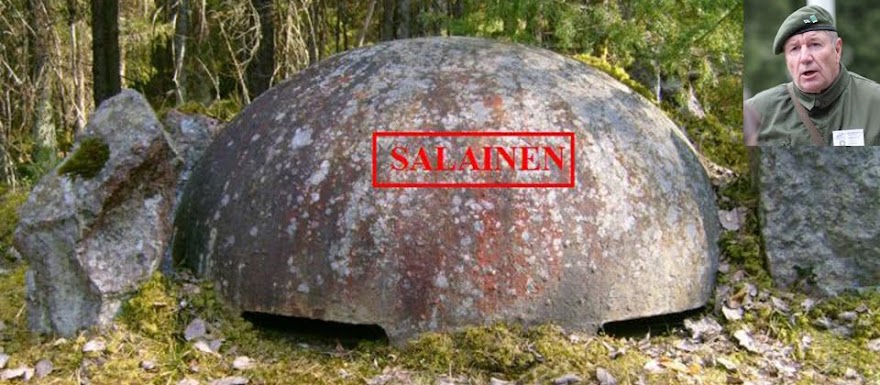Joni Mänttäri tarjoutui kirjoittamaan ja kääntämään blogejani Salpalinjasta in
English. Mikäs siinä, ainakin
Salpalinja-oppaille on hyödyksi lukea erilaisia alan tekstejä, joissa
sanastokin vaihtelee kirjoittajansa mukaan. Pyydän kommentoimaan, miltä Jonin
kieli ”kuulostaa”. Hänen kääntämänsä alkuperäinen tekstini on tässä:
http://salpalinjansalat.blogspot.fi/2010/09/kaivantoesteet.html
Terho Ahonen
* * *
Rock
blockades are the lock of salpa-lines anti-tank defence. Salpa-line has 225
kilometers of this very finnish and big laboured blockade. To support these
blockades, or where rock blockades weren´t possible to build, pit blockades
were made. Salpa-line has these different width and different depth pits about
130 kilometers.
A pit
blockade is like a big ditch, which will prevent a tank from crossing over it.
Naturally,
the effect of the pit blockade was enhanced by stationing anti-tank and
infrantry weapons to shoot parallel to the pit blockade (flanking the enemy).
In any case, pit blockades had to be able to be controlled from defenders own
side.
It was
clear that when an enemy tank sees the pit blockade, it would stop for a moment
to think wether it will try to cross the pit or back up. In that brief moment,
the defenders has a great opportunity to shoot at the side of the tank.
Experiences
about low pit blockades from winter war weren´t good. So, in mid-peace finnish
defence forces focused on rock blockades. During trench warfare new orders were
given about pit blockades measures and in summer 1944 they were shovelled
especially at Vaalimaa- line.
At first,
pit blockades measures were defined at five meters wide and three meters deep.
At these measures, one meter of the pit produced 7,5 cubic meters of gravel.
When finnish defence forces realized, that the pit blockade weren´t enough for
i.e. T-34 tank, they changed the measures to seven meters wide and 3,5 meters
deep. These measures produced over 10 cubic meters of gravel per one meter.
At
Vaalimaa-line, a german pit blockade was transformed to a quick pit blockade.
In finnish version the pits measures were 3,5 meters wide, teo meters deep, and
the bottom of the pit was half a meter wide. The edges of the pit were made as
steep as possible, however the angle had to be at least 55 degrees. This quick
pit blockade produced only 4 cubic meters of gravel per one meter.
Quick pit
blockades were combined with infrantry firing posts and the blockade also
functioned as a connecting trench. Anti-tank posts were stationed in front of
this trench and behind the line, machine-gun and anti-tank cannon posts were
stationed.
Pit
blockades were mostly made with shovels. At Luumäkis end of
Hamina-Taavetti-line, three excavators were in use, appointed by the city of
Helsinki. One of them was steam powered.
The
excavators bucked wasn´t always the best, and the bottom of the pit blockade
became too flat and wide. To pervent enemy tanks from using these flat bottomed
pits as cover, large rocks were put in the pit.
In addition
with pit blockades, enemy tanks movement were made more difficult with slope
cuts. In these cuts the vertical part of the wall had to be at least 1,5 meters
high. To prevent these walls ofcollapsing they were supported with wooden
poles. In some parts, the edges of steep hills were build with seperate rocks
as an tank trap. In theory it would work like this: An enemy tank realizes the
edge of the hill and brakes hard. That´s when the rocks under the tank
collapses sending the tank to the bottom of the hill. After that the tank was
easy to destroy or capture.
This text
was translated from blog "Salpalinjan salat". Original text written
by Terho Ahonen.
JONI
MÄNTTÄRI

1 kommentti:
Hei,
En ole millään muotoa englanninkielen tai kääntämisen ammattilainen, mutta nykyisellään luen paljon englantia ja kirjoitankin englanninkielist tekstiä jatkuvasti joten harjoitusta tulee harrastusmielessä. Ajattelin kommentoida tältä pohjalta.
Äkkiseltään katsottuna tekstin englanti on selkeää, ymmärrettävää ja informatiivista, jos vähän kömpelöä. Tekstissä on jonkin verran tyypillisiä suomenkielisen kääntäjän kielivirheitä, kuten puuttuvia artikkeleita ja puuttuvia suuria alkukirjaimia. Kirjoitusvirheitä on myös jonkin verran. Sotilastermien kääntämisen suhteen näyttää siltä, että Joni on kääntänyt sanoja suoraan vaikka tarjolla olisi vakiintuneita termejä. Esimerkiksi "kaivantoeste" kääntyisi minusta kätevästi "anti-tank trench" tai "anti-tank ditch" "pit blockade":n sijasta.
Summa summarum: ymmärrettävää perustekstiä, hyötyisi kääntäjän tai natiivipuhujan, tms, tekemästä oikoluvusta.
Lähetä kommentti